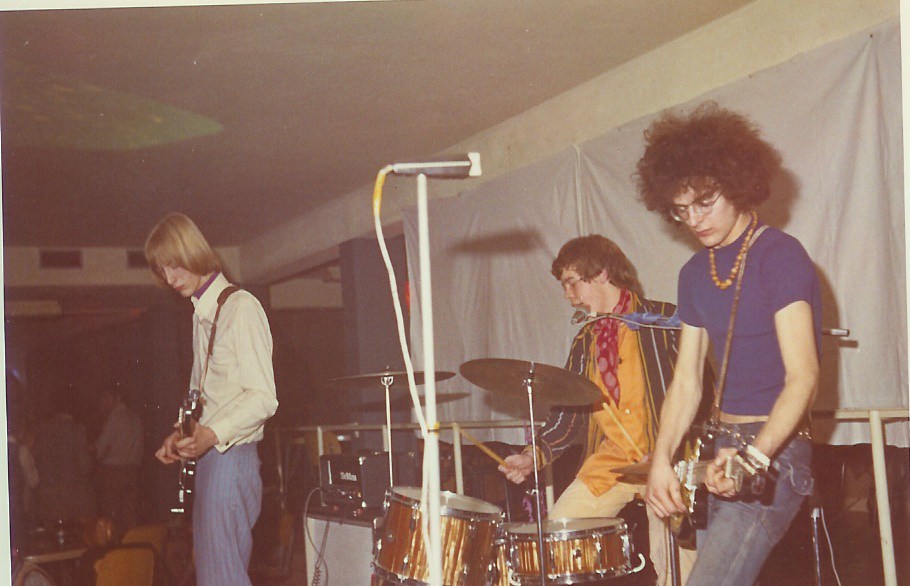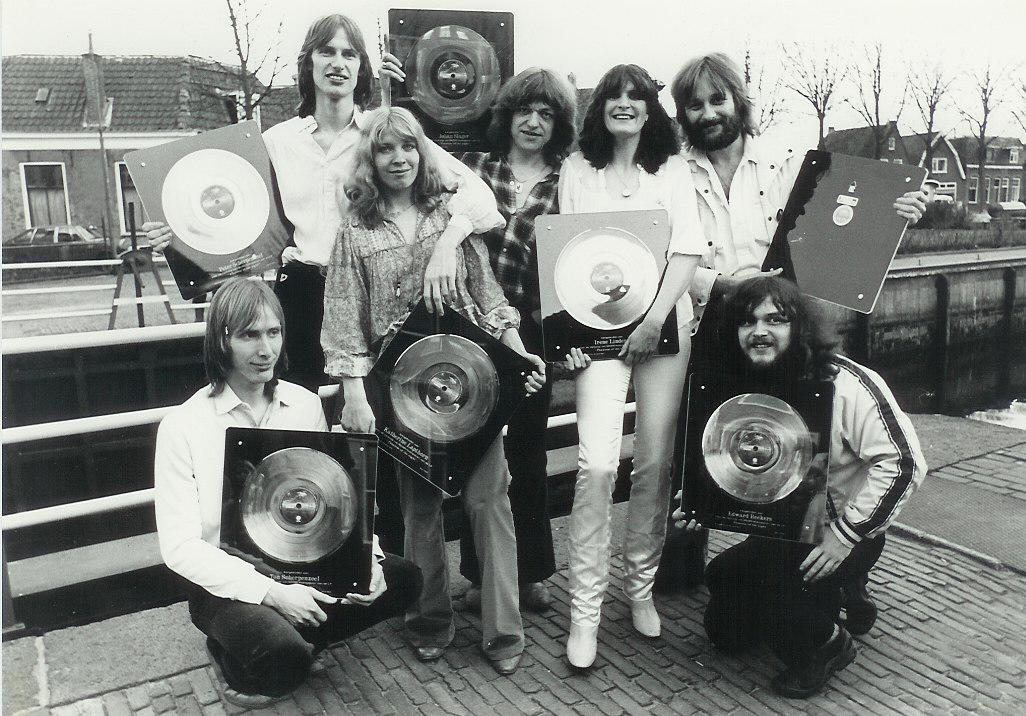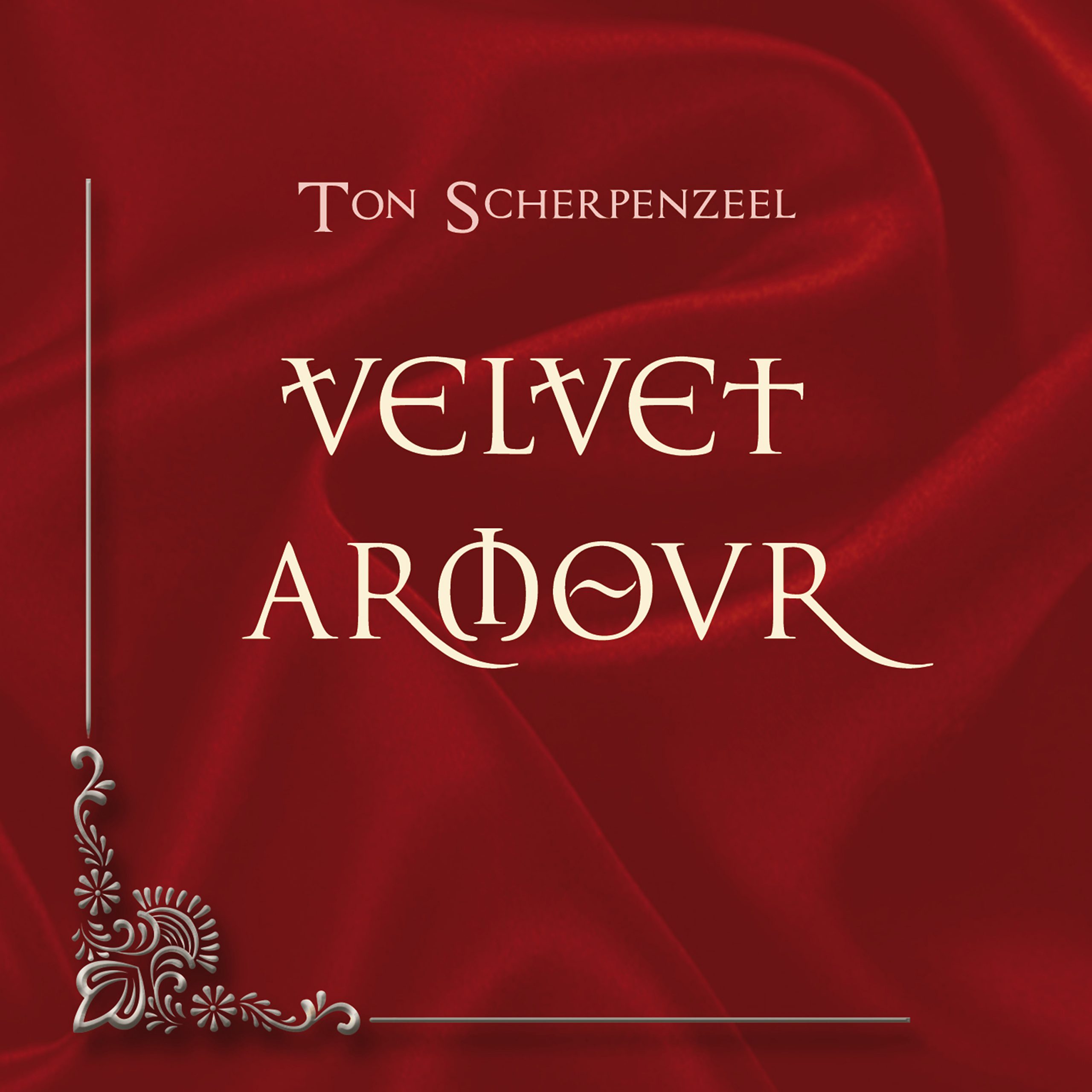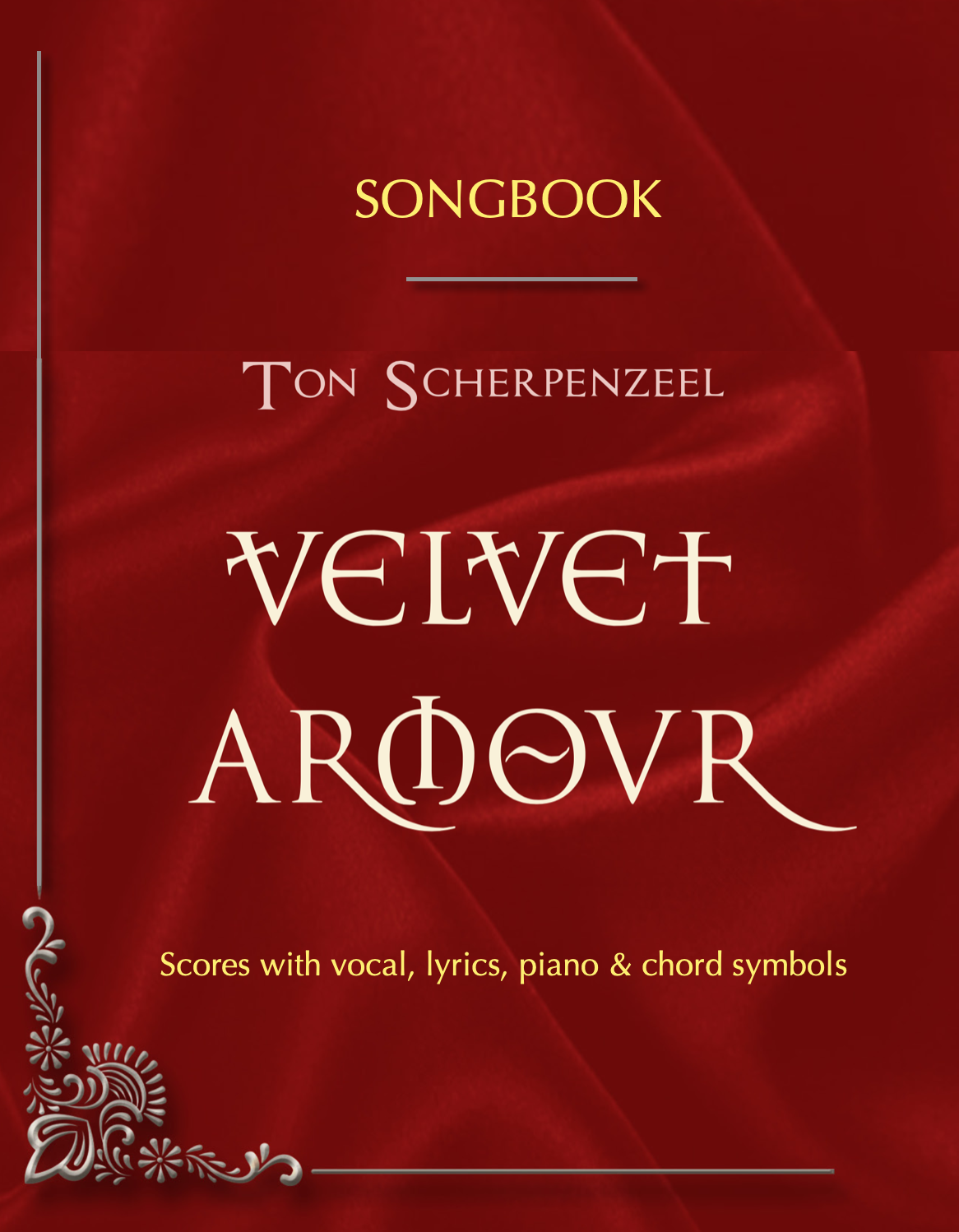
I was recently contacted by Kathy Keller of Friendly Folk Records to inform me that Ton Scherpenzeel (of Kayak and Camel fame) would soon be releasing his fifth solo album on the label. Titled ‘Velvet Armour’ it is described as a blend of Baroque Folk and Progressive rock ballads, and given I have not previously interviewed Ton, it seemed the perfect time to remedy that omission. The result is a wonderful look back over his musical career, as well as discussing the new release, which will enthral many listeners when it is released on October 15th.
Who, what or when is Ton Scherpenzeel?
Quite the existential question to begin with…
I was born in 1952 in the Dutch town of Hilversum. My father was a journalist specializing in what they called Third World countries back then. My mother came from a musical family but never made it her profession. I have two younger brothers.

Who or what first got you interested in music and what were your inspirations during this period?
We had a piano at home when I was young. My parents noticed my eagerness to play, so they thought it would be a good idea for me to have piano lessons, which my aunt started giving me when I was about six years old. But I have always been (and still am) a half-hearted pupil when it comes to real studying and practice- even when I started studying classic double bass at the Hilversum Music Academy when I was 17. This remarkable move was more like an excuse to escape secondary school than a serious effort to end up playing in a classical orchestra.
My focus was on improvising and creating my own music rather than learning the notes someone else wrote. I can read and write music, but it is still an effort. I create music in a very intuitive way.
My first great musical inspiration, that really started to control my life were the Beatles and pop music from around 1964, up to the point that I made my own weekly charts, based upon what I heard on pirate stations like Radio London and Radio Caroline. In 1967 I even managed to have a top 100 every week that I typed out. At the end of the year, I calculated the most successful songs on my own hit parade. Favorite acts that always did well on my personal charts were of course The Beatles, but also Jimi Hendrix, The Kinks, The Move, Manfred Mann, The Beach Boys, The Young Rascals, The Who, and… well, too many to mention.
Needless to say, my homework suffered badly because of this ‘hobby’. I doubled almost every class and basically had no idea what on earth I was doing at school. I wasn’t a rebel; I was just a dreamer and didn’t take school very seriously.
In 1967 I played bass guitar in my first real (neighborhood) band, along with drummer Pim Koopman with whom I later started Kayak. Our setlist mainly consisted of music by Hendrix and Cream. Funny thing is that though keyboard/piano is my main instrument, I favor guitar and bass. I am very much a bassman. But as a composer, I am heavily depending on keys to enable me to make melody, harmony, and bass all at the same time, and be my own orchestra. Some would say drums as well, knowing my ’touch’ on the instrument. And only when nobody else could play the keyboard parts to my songs, I switched to keyboards. I still, occasionally, play bass on my own albums, or even some Kayak albums (when we were in between bass players).

What led to the formation of Kayak, and what were you trying to achieve with the music?
In the late 60’s I started to write my own songs. Together with Pim, we recorded lots of music on his father’s “sound on sound” Sony tape recorder. Those recordings unveiled the outlines of what in 1972 would eventually become Kayak. We did not want to achieve anything concrete yet, and it was by no means professional. One thing was clear though: we were creative and complemented and inspired each other.
In the meantime, we both studied at the Music Academy (Pim did classical percussion). I did learn to appreciate the old composers there and then, with a preference for music between 1400 and 1750. It influenced my way of composing too. I can’t say that the music academy really shaped my writing, but it allowed me to take from it what I felt I needed or considered interesting. It certainly resulted into my first solo album ‘Le Carnaval des Animaux’, and ultimately in ‘The Lion’s Dream’ and now ‘Velvet Armour’.
When Kayak started, we suddenly got catapulted onto national fame (EMI launched us as a new supergroup, though we were all barely 20 years old, had little experience, and had never even played outside Holland). What we wanted to achieve than was, quite simply, that people would listen to and love what we did. To connect. Little did we know then that to succeed in this business you need much more than a bit of raw talent. But we’d find out soon enough, as of course, a band that’s being launched like that can expect not only attention but also criticism, especially when the commercial results do not meet the expectations raised by the company.
What stands out in your mind from those days?
From 1967 to 1973, the youthful feeling that everything was possible, in a creative sense. Rock and pop music were still in its growing-up phase then, experiments were usually applauded- often regardless of their quality- and in our own naive way we were following in the footsteps of our musical heroes, while slowly discovering our own musical voice. And then came Kayak and suddenly my hobby had become my profession.

In the initial life of Kayak, you released 8 studio albums, why did you break up?
In 1979 we returned with a thoroughly revised line up and had our first real commercial success with an album at number one in Holland and a top 5 single hit. But the new band didn’t get along personally, and there were increasing problems with management about financial issues. Also, each consequent album sold half of its predecessor, which caused the internal conflicts to come to the surface and ultimately made the band collapse under its own weight.

You released two studio albums in and around this period, why did you feel you needed to do that?
The first, ‘Le Carnaval des Animaux’, was really a sidestep. At the Music Academy, we did the original classical version of Saint Saens in the ensemble I played double bass in. I thought it would be fun to find out what a pop version would sound like.
‘Heart Of The Universe’ was made while I didn’t have a real band that would play my music, and I mainly worked as a studio musician. Though I wasn’t a solo artist, it was a good way to continue writing and recording my own music. When I met Chris Rainbow in London during the Camel rehearsals, I knew he was the right man for the vocals. I love his voice and might have asked him again if he were still alive today.
In the same year, you released the second solo album you were with Camel on ‘Stationary Traveller’- How did you join the band, and why did you leave only to keep returning?
Camel and Kayak had the same label in the USA, and their label manager sent lots of Kayak albums to Andy Latimer and Camel albums to me. When Andy was looking for a keyboardist in 1984, he approached me. I didn’t have a band of my own at that moment, so I was happy to join them, knowing what a phenomenal guitar player Andy is. I also liked being in a band for once where my only responsibility would be to play as good as I could and fit in.
I never really left. Camel is basically a hired band around Andy Latimer, and he can ask whoever he likes. As I do not fly, the possibilities for touring with me in the US or Japan were limited, not to say non-existent. For those occasions, Andy asked other keyboard players, very kind of him of course but at the end that’s pretty inconvenient if a tour covers all continents. I again did a tour in 2003, but after that, the band had other keyboardists.
Until 2013, when Andy asked me to replace Guy Leblanc because of his health issues. Not the way one would like to re-join a band, but I was glad I could help them out (although we had precisely two days to rehearse). I joined the band at another, last, tour in 2015. In 2017 they again went on a tour covering different continents, which made it impossible for me to join in, so Andy asked Pete Jones. He remains until today.
What led to the reformation of Kayak and the second phase?
Pim Koopman and I had stayed in touch during all the Kayak-less years (1981-1999). In 1996 we began to make some demos that would lead to the reformation of the band, only that wasn’t really our intention at the time. We also didn’t intend to call this project Kayak as no record company seemed to be interested, but in 1999, after our old manager died we were free to use the name again and we chose to do so. Legally we already were, but we were sure that the guy wouldn’t have accepted the fact that we had restarted the band without him Knowing what he was capable of doing, we thought it wiser to avoid the confrontation.
Kayak immediately became incredibly active, releasing a series of albums. What were the major differences between the scene in the ’70s and the 2000s?
First of all, the most important difference was the fact that we were all 35 years older. We weren’t the new and fresh band from the early ’70s anymore, and we were regarded as an older band that after a hiatus of 18 years decided to start again. Which was true, basically, but that limits your possible new audience. Younger people generally identify with younger bands, understandably so. But not an ideal situation when you already operate in a small market like symphonic rock, and that in a small country like Holland, still our base.
It also meant Dutch radio and TV, after the initial surprise and ‘big news’ in 2000, did not show much interest anymore once we were re-established. Sympho rock (or prog rock) was even more obscure than it was in the Seventies. Only “Ruthless Queen” is still being played, as it was a top-5 hit and still loved by many. That is the song our now eighteen albums are generally reduced to. Well, at least it’s something, not everyone can claim a hit single that keeps the shop open. Luckily, we have a loyal fan base that remembers, understands, and that keeps coming out to shows and who buy the records. And of course, in the 2000s slowly but surely internet changed the whole ballgame and national radio and tv became less important.
The bigger record companies, that still existed then, weren’t interested in Kayak around 1999, so we ended up with a small label that meant more dedication, but less exposure and lots of do-it-yourself promotion. But they did good work, without them we even wouldn’t have managed to release more than one album. The internet made another impact on Kayak, and me personally – we found out we had more fans worldwide than we thought. That is inspiring. It is incredible to see someone in Indonesia play “Ruthless Queen” on an old guitar and hear other versions as well. It means that people all over the world are touched by music, which is a musician’s ultimate goal.
Was there ever any thought of disbanding Kayak after the death of Pim? What assisted you in making the decision to carry on?
Sure. But directly after his death, I did not want to make that decision. We put the band on hold for a year, to see how we would feel. Then after a year Cindy, our female lead singer organized a Tribute Concert. It is on DVD. (She had become Pim’s new ‘mate’ in the band). Of course, I couldn’t say no, but to me, it was too soon. Long story short, it did spark the continuation of the band. Pim wouldn’t have been happy if we had stopped, I am sure, though that of course is a strange statement, as he would never know. And I still felt inspired at 59 to write and create, and the rest of the band was positive, so, why not. After all Kayak had been without Pim before, between 1976 and 1981. It would never be the same, but I always intend to keep his majestic legacy alive within Kayak.

There was another reset of the band after the release of ‘Cleopatra – The Crown of Isis’. What happened at the time?
Hard question. Officially, I don’t know why our two lead singers decided to leave. They never gave a good explanation, as far as I am concerned. Without going too much into detail, Pim’s death caused a change in the band, in the hierarchy, and in the attitude towards me. Everyone claimed their position in the band, while at the same time they all had their own agenda, which made it impossible for me to organise anything big and theatrical, as we planned to do with ‘Cleopatra’. So, after we’d recorded ‘Cleopatra’ (which they had been reluctant to do anyway, but still did) I told them that if they weren’t available, they forced me to look for singers elsewhere. I still considered them my first choice, and I told them so, but the situation had become unworkable. The mere fact that they could be replaced was unacceptable to them, and I was accused of turning Kayak into a ‘project’. Then they decided to leave and announced that two weeks before the tour started. We did the tour, but you can understand, that wasn’t a whole lot of fun.
Since that time, the band has been stable, releasing two albums, including the recent ‘Out of This World’. Musically how would you compare this line-up to the earlier versions of the band?
Back to five instead of seven. Not for musical but for practical reasons. Communication is easier, the agendas are aligned much quicker. As a band, we have to work harder to make all the arrangements fit. But we have brilliant musicians in the band, so it works. It’s the third time Kayak has seen such a drastic change in line-up, and of course the sound changes. That’s life. Life is change. Some songs we cannot play anymore because of the trimmed down line up, but there are also lots of songs that benefit from the more transparent sound. You win some, you lose some.
No one in the band (except for drummer Hans perhaps) has a past in Kayak. Hence, no claims, no rivalry, and no personal shit that can so easily destroy the working relationship. We are not a band that makes lots of money and can live off the revenues and can afford to dislike each other. If it’s not at least a pleasure to work together, it’s not worth it.
Eight years on from your last solo album, and you will soon be releasing ‘Velvet Armour’, a very different work from what people may expect given your history with Kayak. How would you describe it to others?
If you take Kayak as a reference, it is quite different indeed. But there are similarities. You might say it follows a path that Kayak never explored in full but opened up. There has always been a folky/classical side to the music of Kayak, but as a rock/pop/prog whatever band we didn’t take it as far as I do personally.
Style-wise it is comparable to ‘The Lion’s Dream’, my solo album that was released in 2013. It’s what I do without a band. An old soul in a new age, it says in the press bio, and that is pretty much what it is. No electric guitars, no ordinary drums as you might expect from a rock musician. Synths and samples, yes. The result is baroque, renaissance, and folk- but all with a modern and personal twist because I am not a purist- it’s really intuitive what I do. I use prog and pop song structures and I find the combination works.
Both Rens van der Zalm and Annet Visser were involved with ‘The Lions Dream’, but how did you decide on which musicians should be involved with this project and why?
Annet and Rens are great musicians and easy to work with. They understand where I am coming from and where I hope to go, musically. If I could play the flute, I’d play it like Annet. Her phrasing and timing are always spot on. Rens has a strong folky background and I ask him to play on the tracks that need that unique feel. Since I have been around in the music business for quite some time now, I know a lot of musicians. I ask the ones that enjoy what I am asking them to do and are capable of doing that, of course. The Matangi string quartet, for instance, is a classical ensemble but they have also played in different styles, like rock, or even hip hop and with a DJ. They are very professional and all-round so I can ask them to play almost anything. You can hear them in “Mirrors of Versailles” and “Tempus Fugit”. The first violinist, Maria Paula Majoor, plays the lead on several tracks like “Lilly’s Lament”. I asked Irene Linders to do some background vocals, so the vocal sound would be a bit more diverse.
The arrangements are fascinating, moving and changing between songs, with different percussion and instruments having a major impact on the overall sound. Did it take a long time to record? What was the approach?
After ‘The Lion’s Dream’ I wasn’t sure whether I wanted to do another album like that. But one or two years ago I realized that in the meantime I had written so much that was perfectly in line with TLD, that I was in fact halfway already to a new album. Only then I decided to focus on what would eventually lead to ‘Velvet Armour’. So, it took like six years, but as it was always a side project, until last year, I only worked on it on and off. Sometimes I left it alone for months. If I had one concrete musical goal, it was that I wanted to keep the essence of my demos alive. So often I found that my demos were better than the final, official recording. Different vocals, different studio, a different approach, all good and neat but the feel and energy were often lost. That’s a musician’s issue in general, not mine alone, as you probably know.
You are not often thought of as a lead singer, but your voice works incredibly well on this album. Is this something we can expect more of in the future?
I don’t consider myself as a lead singer. It’s born out of necessity. All my musical life I have been looking for singers that could perform my songs in a totally credible way. They should sound as if they’d written it themselves, and there should be no distance between the voice and the notes. And no matter how good they were-and they were it wasn’t always what I wanted to hear. I don’t know why, but I guess I was basically looking for someone like me but with a better voice. Once someone else sings it, something changes, and it takes the music and feels away from me. This is not an ego thing- strange as it may sound, for a composer and musician I have a relatively small ego. I had strong doubts whether I should do another album like ‘The Lion’s Dream’ and do the lead vocals again. But there was no other way, I can’t escape myself.
You have described this album being inseparable from you as a person. What exactly do you mean by that?
It has a lot to do with what I told you about the use of my voice. But also, when I write for Kayak, or other artists or projects, it becomes less personal and although I try to stretch our limits, we’re still a rock/pop/prog band. On ‘Velvet Armour’, I don’t have to consider all that and I take total freedom to do any style I want. And my musical heart, I am discovering more and more as I get older, lies in and around the 16th, 17th century and folk. Classical music and folk weren’t so much separated in those days. Archaic, timeless music. Unlike rock music, really. But maybe in 200 years rock will have become timeless as well.
Another personal aspect lies in the song itself. If I sing ‘I’ I mean ‘I’, (although I use lots of metaphors, so the listener can interpret and imagine). With Kayak, and I am not singing it, it becomes a song that does not necessarily have to be autobiographical or personal. I write, and imagine a certain conflict, feeling or story that I can relate to. If all the sad songs I wrote for Kayak were about me personally, one would imagine that I have had quite a terrible life.
Are there any plans to play any of this album live?
No, not at the moment. I have no ambitions to do that as it would involve a lot of other distracting and demanding things like travelling, rehearsing, finding people, get the budget, in short: running a band. And I already have Kayak which is a lot of work. Still, I am not ruling out the possibility of playing live completely, but the setlist would probably only contain instrumentals. I couldn’t sing these tracks live, as I often double (or triple, or quadruple) the vocals to reach the effect I want to hear. But who knows where this album will take me?

Why did you revisit the Kayak number “My Heart Never Changed” for ‘Velvet Armour’? It has been more than 40 years since you first recorded it.
On ‘The Lion’s Dream’ I covered no less than three Kayak songs, for no other reason than that they are the musical bridge between everything Kayak and my solo work. And they don’t even stand out, style wise, I think they all fit and could have been written recently. I found “My Heart Never Changed” to be such a link too. It was as far as I could take Kayak in that direction back then, without leaving the rock/pop/prog path. This goes to show what might have happened had I left that path instead of continued as a rock band.
At the same time, it could generate interest for the band from people that never heard of Kayak – there’s still lots of them around, I noticed. And I think I have stayed closer to the original than any Kayak line up after 1975 could have done. It’s not as if I did not have enough material to fill this album, because I discarded at least three tracks that I may use later. But if there’s gonna be next solo album like this, I don’t think I’ll do a Kayak track again. I’ve done it, made my point, now move on.
Why did you decided to produce a lyric/composition songbook to tie in with the release? What does it include?

I offer Kayak sheet music too on the band’s website, and there is some demand. To me it makes the picture whole. It is not strictly necessary, but it’s great when people are interested enough to try and play it themselves and honestly, I am flattered by that. Then it’s convenient to have the score. It includes vocals, lyrics and melody parts, basic piano/keyboard and chord symbols. Of course, I couldn’t fit in the complete arrangement in three staffs, but I tried. And if there are any mistakes in the scores, they’re mine.
Why did you choose “River To The Sea” as the lead track from the album?
It’s one of my own favourites and I think it is an accessible track for a larger audience too. The video consists of stock footage I assembled and put together. The clip brings the almost pastoral atmosphere of the lyrics alive – although the river in this case really serves as a metaphor for the never-ending cycle of life, and how there’s hope and comfort to be found in that.
Where can people best find more about you and your music, and what is next for Ton Scherpenzeel?
There are several informative sites, of course: www.tonscherpenzeel.com, there is the Kayak site (www.kayakonline.info) and both have Facebook and Instagram pages for updates and latest news.
What’s next? I’ve done three major record projects this year so far and one or two small ones as guest on other projects, all these releases add up to about 40 songs. Let’s see where this album takes me, first. I have an open mind, and don’t intend to retire just yet.
So, there we have it, a wonderful journey through time in the hands of the master keyboard player and composer Ton Scherpenzeel. His new album, ‘Velvet Armour’, will be available exclusively on the Friendly Folk Records Webshop on Bandcamp until December when it will become available elsewhere. Note, if you pre-order the album at https://tonscherpenzeel.bandcamp.com/releases then you will immediately be provided with the digital download of the track, “My Heart Never Changed”. I urge all those who enjoy Baroque Folk music with a touch of Prog ballads to discover ‘Velvet Armour’, as it really is a wonderful album.
Interview conducted by Kev Rowland



